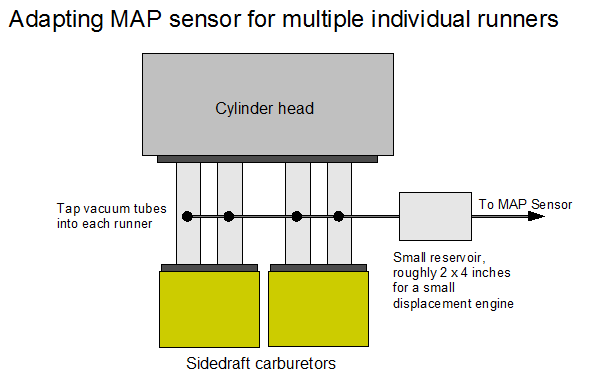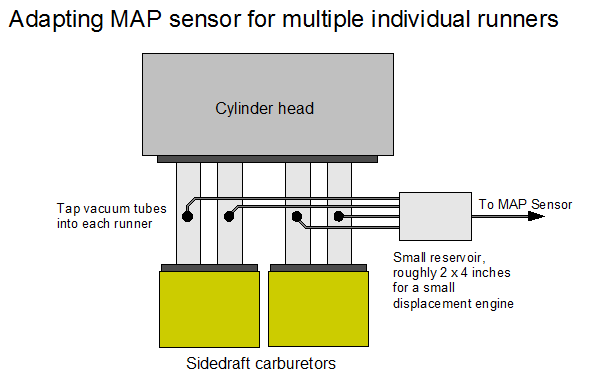Choosing between MAP or TPS
MAP vs. TPS
The MJLJ offers two separate mechanisms for measuring engine load. See the guide below for determining which is best for your engine.
MAP Sensor
A MAP sensor determines engine load by measuring manifold pressure (or vacuum).
It is typically considered more accurate because it directly measures how the engine is 'breathing' and automatically adjusts for varying conditions (altitude, temperature, humidity) and modifications to the engine which affects it's volumetric efficiency.
The MAP sensor requires a stable source of manifold pressure across all cylinders. If you have multiple runners, like a multiple sidedraft configuration, you will need a balance tube with a miniature 'plenum', or accumulator, to smooth the pressure reading across all cylinders.

One approach to reference pressure across the manifold runner
Throttle Position Sensor (TPS)
A Throttle Position Sensor measures the angle of the throttle plate, which can be used to infer engine load. Use this configuration if you have very aggressive cams and a manifold pressure reading is unstable, especially at idle. The sensor will need to be adapted to the throttle linkage and then wired to the MJLJ.
The Throttle Position sensor is an external device wired into the MJLJ connector and must be acquired separately from the MJLJ. These units can be purchased new, or obtained from an auto salvage yard.
Which is best?
Engine configuration
In most cases, the engine configuration provides the definitive answer.
| Engine configuration | Choice |
|---|---|
| Forced Induction | MAP |
| One carburettor for all intake runners | MAP |
| Side-draft carburettors or throttle bodies with separate runners | TPS or MAP (see personal preference below) |
| Extremely aggressive or lumpy cams | TPS |
Personal Preference
The gray area around separate runners may come down to personal preference. Some value the simple installation of TPS which have reported good results. Others believe basing load on an accurate MAP reading is of primary importance, and make the extra effort to measure the map reading by constructing a separate plenum and balance tubes.
In these cases there is no exact 'right' answer. For the curious DIY'er it may be worth their while to test one approach, and then evaluate the other.
An excellent discussion on adapting a MAP sensor to individual runners can be found here.
Unsure?
If you still can't decide and you're running bike carbs or side-draft carbs where it's easy to mount a TPS, then choose TPS.

